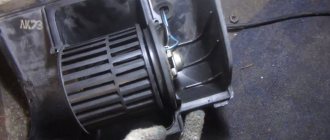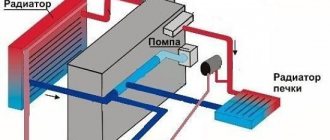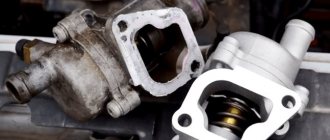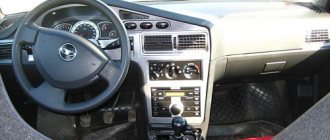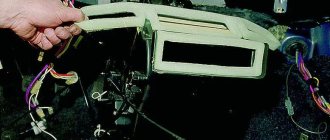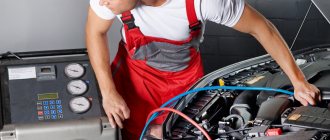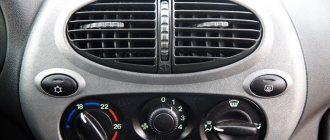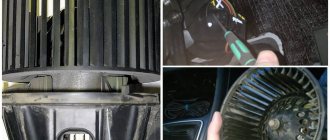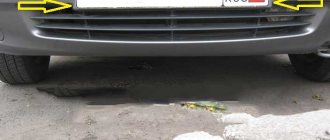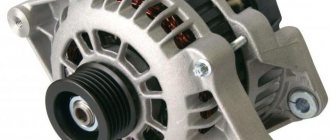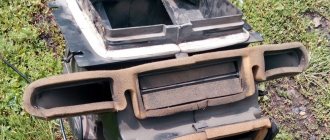With the arrival of cold weather, some drivers are puzzled by finding the reasons why the heater in the car does not heat well. Moreover, sometimes the stove in the car begins to work so poorly that it becomes absolutely unable to warm the interior. In addition, in severe frost the situation is further aggravated by glass freezing. What to do in such cases?
In fact, there are not many reasons why the heater in a car may not work efficiently, and below we will look at each of them.
At the end of this article, watch a video with a detailed description of the reasons why stoves in cars do not work well and how to eliminate them.
In the meantime, you are figuring out the reasons why the stove is not heating well, we recommend that you pay attention to alternative methods of heating the car interior:
- How to choose a car interior heater from the cigarette lighter;
- How to choose a heated car seat cover.
Of course, these “warmers” will not replace the standard stove in the car, but they will undoubtedly add comfort even after it has been repaired.
Low coolant level or air lock
avto-cool.com
Due to a leak at the connection points of the pipes or on the radiator, the coolant level in the system may decrease. This will worsen its circulation inside the heater radiator and affect its heating. Air pockets that form when replacing or adding antifreeze have the same effect.
What to do
Check the coolant level and add if necessary. If there are leaks, fix them.
To get rid of the plug, open the cap of the expansion tank and radiator (if equipped), and then squeeze several times with your hand all the thick hoses that you can reach.
Start the engine, turn the heater to maximum and let the car idle until it warms up completely. To be sure, it would be good to drive onto an overpass or some kind of hill to lift the front of the car and help the air escape. This may cause a small amount of antifreeze to splash out - be careful.
The stove blows cold air: possible causes of the malfunction
In most regions of Russia, it is impossible to do without a car interior heating system. However, sometimes you may encounter a situation where, with the onset of cold weather, the need for heating arises, but when you turn on the stove, you feel that cold air is coming from the air ducts. In this article we will look at why the stove blows cold air and what to do in such circumstances.
How does a car heater work?
The warm air entering the car interior is generated by the engine and coolant. By washing the hot parts of the engine, antifreeze cools them. The heat generated in this way is released into the atmosphere in the summer; in the cold season, the liquid entering the radiator through the pipes is partially used to heat the interior.
The car interior is equipped with an electric motor with an impeller that drives air through a hot radiator. The heated air circulates inside the car. The temperature is controlled by the amount of hot antifreeze that passes through the stove. To regulate the air blowing from the stove, there are dampers in its body, which are controlled by a gearmotor of the control unit. The fan rotation speed is also adjusted from this unit, through a rheostat.
We talked about what the stove is, now let's move on to identifying malfunctions in its operation. Thanks to a competent check, you can save not only time, but also money. When diagnosing the reasons why the stove is blowing cold air, it is important to understand what exactly has stopped working. That is, first of all, it is necessary to determine which particular system node has failed.
So, let's look at why it happens that the stove does not work and cold air blows.
Why does the stove blow cold air?
Problems with the operation of the stove in the car interior can be expressed in the following:
- the stove blows cold air;
- the stove starts working if you press the gas pedal;
- the stove blows either cold or hot air;
- air stopped flowing from the deflectors into the cabin;
- the stove works, but cold air enters the cabin;
- fan operation is possible only if the speed regulator is moved to the extreme speed position;
- During operation of the stove, extraneous sounds are heard;
- hot air starts to blow when the crankshaft is running at high speeds.
Due to such malfunctions, not only does the air inside the car not heat up, but the engine as a whole does not function normally, which means the problem deserves special attention.
The reasons why the stove blows cold air can fall into one of two large groups.
- Malfunctions of the cooling system as a whole.
- Thermostat
Most often, the reason that the heater in your car is blowing cold air is a broken thermostat or switch. Thanks to this element, the coolant moves in the right direction. If the thermostat fails, antifreeze will pass through the main radiator, the time required to warm up the engine will increase significantly, and if the air temperature is low, it will not warm up.A malfunction of the thermostat is primarily indicated by the coolant temperature indicator. If the element is faulty, it will take a long time for the antifreeze temperature to rise. In addition, you can feel the hose that comes from the main radiator. If, after warming up the engine, the hose does not heat up and the heater blows cold air, then we can conclude that the thermostat has failed and needs to be replaced.
- water pump
Another reason that the stove is blowing cold air may be the ineffective operation of the pump - the pump that pumps antifreeze. Pump failure is possible in the following cases:— malfunction of its drive (belt break); — jamming (bearing failure); - rotation of the impeller (blades that drive coolant) or its destruction, as a result of which it will not be able to effectively pump coolant.
As a result, the system will not warm up evenly - if one part overheats, the other will remain cold, which will lead to overheating of the engine. The antifreeze temperature sensor will indicate a malfunction.
If the pump is ineffective, the heater will operate at high engine speeds. The volume of coolant passing through the radiator at idle speed will not be enough for warm air to blow from the stove.
- Cylinder head gasket
A nailed or burnt gasket, which is located between the cylinder block and its head, allows gases in the cylinders to enter the coolant.This malfunction can be judged by white smoke coming out of the exhaust pipe, a sharp increase in the level of antifreeze, as well as gurgling sounds in the expansion tank. This malfunction is quite serious and requires disassembling the engine.
- Air in the system
The operation of the heater at high engine speeds indicates the presence of air in the cooling system. Air has low thermal conductivity and is therefore not suitable for the rapid spread of heat. This situation adversely affects not only the operation of the stove, but also the functioning of the engine as a whole.Due to the design features of the stove, air accumulates in the area of its radiator. If the antifreeze does not move intensively enough, for example, when the engine is idling, the coolant does not expel air from the radiator, and the heater blows cold air.
The entry of air into the system is indicated by poor operation of the heater at low speeds, and when they increase, you will not only feel a blow of hot air, but also gurgling sounds in the area of the stove. First of all, the cause of air entering the system should be determined. This may be due to insufficient tightness of the system, leading to air suction, or to a small volume of antifreeze. But before bringing its quantity to normal, it is important to find out and eliminate the reason for the decrease in its volume.
If the heater's radiator has been replaced, but it continues to blow cold air, air has most likely entered the system. To resolve this problem, please refer to the operating instructions for your specific vehicle. To eliminate the air lock that has formed in the heater radiator, it is necessary to disconnect the hoses, then pour coolant into the upper one, while it will pour out through the lower one. The procedure must be continued until air bubbles stop coming out of the hose.
On a number of cars, you can get rid of air in the heating system by placing the car at a certain angle and starting the engine at high speeds.
- Heating system malfunctions.
If the heater blows cold air while running and there are no faults in the cooling system, most likely the problem is in the heater itself. That is, the coolant reaches it, but cannot penetrate into the cabin in the form of hot air. The malfunction may concern the radiator or heater tap.
- Heater radiator
If the heater blows cold air at speed, the problem may be a clogged heater core. The blockage prevents hot coolant from passing through it, therefore the air does not heat up. This situation is possible in the following cases:— use of various cooling system sealants; — long-term operation of the car using low-quality antifreeze or water; — the car and radiator are of considerable age.
The listed reasons lead to the accumulation of dirt in the cooling system. Since the channels in the stove radiator are the narrowest (due to the need for slower fluid flow and greater heat transfer), they are most susceptible to contamination. The problem can be corrected by flushing or replacing the radiator.
- Faucet
Another reason that the heater is blowing cold air may be a closed heater tap. This problem occurs in older cars. The situation is possible if there is a malfunction of the faucet itself, which is stuck in the closed position, or in the control drive.In the latter case, the reason lies in the drive (cable) coming off the mounts. In this case, it must be returned to its place and secured. The faucet is replaced as an assembly. Modern vehicle models do not have faucets; they are equipped with dampers that close the radiator when there is no need for hot air. If the damper fails, the stove also stops functioning normally.
Cleaning the radiator of a car heater
What to do if the stove blows cold air and the radiator needs to be flushed? There are several ways to do this.
- Flushing the radiator with complete removal.
Dismantling a radiator is quite difficult; you cannot do it without knowledge of the car’s structure. However, in certain cases there is no other way to fix the problem. If you do not have positive experience with flushing the radiator, you should seek the help of professionals by contacting a service center.
Flushing with removal of the stove is required when other methods of cleaning the radiator have proven ineffective.
By removing the heater radiator, you can detect a number of faults. For example, you can see if the fan is functioning normally, and if there are problems, replace its motor.
In addition, only by dismantling the radiator can it be washed from the outside. If your car does not have a filter, be prepared for a large amount of dust and debris to accumulate on the air intake. The most dangerous is poplar fluff, which forms a thick caked crust. As a result, the heat exchanger stops blowing and generating heat.
You can assess the condition of the pipes, the degree of contamination of the radiator cells, as well as how tightly the air duct dampers fit when they are closed by removing the radiator. If in the closed position there are voids between the dampers and the stove, then air will come from outside, bypassing the radiator. Owners of not only budget but also expensive cars may encounter a similar problem. In the latter case, you should immediately contact a car service to solve the problem.
By dismantling the radiator, you can understand whether the cooling system as a whole is working. If the radiator is not functioning, cleaning will not help; you can solve the problem by replacing the entire cooling system. The cooling system becomes dirty gradually, but the moment the stove fails due to blockage is always unexpected. Repairing copper radiators involves sealing them, but if we are talking about aluminum, then replacing it will be a more expedient and cheaper solution to the problem.
Radiators are washed without using a pump, a sufficiently powerful pressure of hot water and a special bath. Washing is carried out using both homemade and professional cleaning products. Some methods are only suitable for a removed radiator, and using them at home is dangerous to health.
- Washing with sulfuric acid.
To flush with sulfuric acid, the radiator must be removed, otherwise the rubber and plastic parts of the cooling system may be damaged. Today, this method is used very rarely and requires careful adherence to safety measures.
It is imperative to use special goggles, rubber gloves, a gown and a household respirator to protect against inhalation of toxic fumes. In addition, it is necessary to use special tongs or grips that prevent direct contact with the solution.
You also cannot do without a hydrometer, with which the concentration of the washing liquid is measured. Washing is carried out with a 15% solution of sulfuric acid. The hydrometer reading should be 1.1 g density per 1 cm3. The solution contains distilled water and battery electrolyte.
Remember that you should never pour water into acid; the acid must be carefully added to the water.
The method is suitable for flushing old copper radiators. Aluminum or zinc elements will fail after such treatment.
- Cleaning with hydrochloric acid solution.
You should also not resort to this method if you lack experience. In addition, hydrochloric acid is not commercially available. As in the previous case, strict adherence to safety precautions is necessary.
If the contamination that has caused the stove to blow cold air is strong enough, then the cooling system should be filled with a 2% acid solution (50 ml per 1 liter of water). Then you will need to thoroughly and carefully flush the system with plain water. If the radiator is made of parts that are susceptible to corrosion, this cleaning method is not suitable.
- Washing with caustic soda (caustic soda).
This method also causes heated debate. When using it, you must follow safety precautions; you cannot start washing without protective gloves; in addition, keep in mind that soda can corrode fabrics and is toxic.
Caustic soda is an alkaline detergent that cannot be found commercially. Using even a 5% solution will damage an aluminum radiator. The product is also harmful to zinc parts, zinc and aluminum alloys. It is recommended to be used if it is necessary to clean equipment before repair.
To prepare the solution, you need 50 g of caustic soda per 1 liter of distilled water. The radiator grille is placed in a bath filled with solution for several minutes, then removed and checked for dissolution of contaminants. If necessary, the procedure is repeated. At the end of the treatment, the radiator is washed with distilled water and dried.
Today, there are various ways to clean radiators from contaminants. Some of them raise reasonable doubts, since the necessary ingredients are not freely available, and the processing process is labor-intensive. It is better to resort to methods with minimal risk of damage to the vehicle and your own health, and also do not forget that you assume all the risks of such work.
Where in St. Petersburg to repair a car with maximum benefit
Our auto centers will quickly and efficiently repair your heating system. The company has been operating on the market for more than 20 years, providing high-quality services for servicing and repairing cars of all brands and any year of manufacture at affordable prices. Our service stations have the latest equipment and are equipped with special tools, and our employees are highly qualified.
You can get more detailed information on our website or find out directly from managers. We will be glad to see you at our service center!
Cabin filter and air duct clogged
rightwayautorepair.com
Sometimes the cause of a poorly functioning heater can be a dirty cabin filter or leaves, insects and dust getting into the air duct due to its absence. In this case, the radiator itself warms up, but cannot release heat due to the weak air flow.
What to do
Check the cabin filter and replace it if necessary. If there is no filter at all, although there should be one, then clean the air duct of debris. If possible, get to the heater core itself and blow it thoroughly with compressed air.
Thermostat malfunction
e46zone.com
This is a common cause of furnace problems. If the thermostat sticks in the closed position, then the breakdown is noticed immediately, since in this case the engine overheats. But if we are talking about an open or slightly open position, then, as a rule, drivers find out about this only with the onset of cold weather.
If the thermostat is constantly open, the coolant always moves in a large circle. As a result, the engine takes a very long time to warm up, and sometimes does not warm up completely. Of course, there can be no question of any normal operation of the heater. This increases fuel consumption, and in the case of an automatic transmission, its warm-up time also slows down.
Signs of a faulty thermostat are more or less tolerable heating of the stove when driving at low speeds and cold air from the ventilation when driving on the highway. The fact that the thermostat is constantly open is indicated by the simultaneous heating of both radiator hoses. Normally, when starting the engine, one of them should be warm and the other should be cold.
What to do
There is only one option: replace the thermostat with a new one.
Why doesn't the heater fan work?
Heater fan not working
The stove fan does not work if:
- The fan fuse has blown;
- The heater switch is faulty;
- Problems with wiring, connection reliability;
- The fan motor has failed.
The simplest thing is a blown fuse. In this case, simply replace it with a new one. However, if the fuse burns out again, you need to look for the cause, a short circuit somewhere. The fan switch can be easily checked by shorting the wires that go to it. Find out which terminals of the switch should close and jump the corresponding wires. The fan started spinning - the problem was found. Switches are usually non-removable, so replace the one that is faulty immediately.
Article on the topic: Mazda 6 new model 2016
Problems with wiring rarely occur, but if in doubt, check that all connections are secure and that there are no oxidized contacts or broken wires. If suspicions for all of the above reasons are not justified, it means that the motor itself is faulty. It is also usually beyond repair and will need to be replaced.
Faulty heater motor must be replaced
Heater core blockage
macsworldwide.com
Another common reason. Typically, blockages occur due to poor-quality coolant, mixing different fluids, adding water, or using sealants for the cooling system. Deposits and scale that form inside the radiator completely clog the honeycombs and block the circulation of antifreeze.
What to do
Removing and replacing the radiator is quite difficult on any car, so try flushing it first. You will need a special product or regular citric acid (100 grams must be dissolved in 5 liters of distilled water). The standard hoses are removed from the radiator, and others are connected to the inlet and outlet. The liquid is heated to 80–90 °C and supplied to the radiator using some kind of pump.
Unfortunately, flushing is not a panacea. It helps in about half the cases. In addition, due to the flushing of internal deposits, a leak may form.
If flushing does not produce results, only replacing the radiator will help. In this case, it would also be a good idea to completely flush the entire cooling system and replace the fluid.
Preventing the operation of the stove in the car
In order for the stove in your car to heat well and not let you down at the most inopportune moment, you need to follow a few simple tips.
- Keep the radiator clean. Light contamination from the outside of the radiator can be removed with a vacuum cleaner. Flushing the engine cooling system, with which the heater radiator is inextricably linked, will help get rid of internal deposits and blockages in the channels.
- Use good antifreeze . High-quality antifreeze is the key to long-term operation of not only the stove in the car, but also the engine. Remember this and do not forget to replace it in a timely manner.
- Change the cabin filter more often . A clogged cabin filter will certainly create problems not only for the operation of the stove, but also for the air conditioning and cabin ventilation system as a whole. In addition, dust and pollen deposited in the filter can pose a serious health hazard (especially for allergy sufferers).
If, at an outside temperature of minus 25 °C, your car’s heater heats the interior to +16 °C from below and up to +10 °C from above, then it can be considered quite serviceable. To avoid problems, it is recommended to carry out preventive measures in a timely and responsible manner that will allow you to enjoy a comfortable ride in a well-warmed-up car.
And remember, the longer the service life of the machine, the more attention its heating system requires. This applies to all cars, regardless of country and manufacturer.
Pump impeller wear
petroavtotrans.ru
A pump is a pump that pumps antifreeze from the engine, ensuring its continuous circulation throughout all components of the cooling system. A pump breakdown is quite difficult to miss: in this case, the engine will immediately overheat and boil.
When the impeller blades wear out due to the aggressive effects of water or low-quality antifreeze, the pump's performance drops significantly. It is still enough to ensure that the coolant somehow circulates and the engine does not overheat, but it is no longer enough to fully warm up the heater radiator.
What to do
As a rule, pumps are not repaired. Therefore, the problem is solved by replacing the faulty unit with a new one.
Water pump
If the stove blows cold air at idle, then the cause of the malfunction may be worn impeller blades.
This mainly happens when the car is no longer fresh or different coolants were used in the system. What is happening at this moment? A worn pump impeller at low engine speeds cannot create optimal pressure in the system for full circulation of antifreeze. To fix this problem, you simply need to replace the pump.
Fan problems
Coldness in the cabin can be caused not only by insufficient heating of the heater radiator, but also by weak ventilation. The fan is to blame for this because it does not provide the necessary air flow and heat removal from the radiator.
What to do
If the fan does not work at all, then everything is clear. Most often it rotates, but at insufficient speed. This happens due to wear on the motor brushes or jamming of the bearings. In both cases, repairs will be required from an auto electrician.
How to properly warm up a car in cold weather
Every car needs proper warming up in winter. Even a novice driver should know exactly how to heat it. The most important thing here is that the car must be warmed up in advance (15–20 minutes before the planned trip). This way it will work most efficiently, even despite the sub-zero temperature.
1. Preparing the car engine for starting
Before you start the engine, you should briefly turn on the low beams. It only takes half a minute for the battery to “wake up”. Then we depress the clutch so that the starter is disconnected from the crankshaft and gearbox. After that, turn on the neutral gear.
This will make starting the engine easier, despite the severe frost. Does your car run on diesel fuel? Then we wait until the spiral of the diesel heating plugs goes out. It is best to do this manipulation with glow plugs 2-3 times.
2. Starting the engine
It happens that the engine does not start immediately. You should not immediately try to start the car again. This will only drain the battery and ruin the starter. It will only take 30-40 seconds to restore the battery, after which the car should start.
Finally, the car started. Don't rush to warm up the windshield. Wait a couple of minutes. The engine has not yet warmed up enough to allow energy to be drawn from it.
We do not recommend turning on hot air blowing on the glass. There are probably microcracks on the windshield, so you will only make them bigger. To begin with, the air flow should be directed into the interior, then you can switch it to the glass. This way the car will warm up correctly in winter.
Now that the car has started and heated air enters the cabin, we begin to clear the snow from the outside of the car. This way you will spend every minute of your precious time wisely.
Carefully remove snow from the windshield and side windows. The cleaner they are, the better the driver will be able to see the road situation during the trip.
In the cold season, the car will take longer to warm up, the lower the temperature outside. Warming up also affects how actively the machine is used. Usually 15–20 minutes are enough for the car to warm up well.
3. Start of movement
A cold engine will run at higher speeds and idle. Once the car starts, the tachometer will show 1,200–1,300 rpm. When you finish warming up the engine, this figure will drop to a stable 1,000 rpm.
Have you noticed a drop and stabilization in speed? This means the car is ready to go. Moreover, at the very beginning of the movement (10–15 minutes), the car should drive at low speeds. You should drive 1,000 meters moving no more than 40–60 km per hour. Then gradually increase your speed.
By doing this you will give the engine enough time to warm up. Otherwise, the motor will experience high loads, its parts will wear out quickly, and the machine will break down.
Damper servo drive failure
drive2.ru
Another reason why the stove heats up, but the heat does not reach the interior, is a malfunction of the damper. In all modern cars, the heater radiator heats up constantly, and heat comes from it only when the air duct damper is open. If the damper does not open or does not open completely, there can be no talk of an optimal temperature.
The damper is driven by a servomotor, which is controlled by a knob or buttons on the climate control panel. The problem can be either a breakdown of the servo drive itself or slipping of the cables or rods that drive the damper.
What to do
This problem can only be identified and corrected by disassembling the heater panel. If rods or cables have come off, they need to be returned to their place. A servo drive malfunction, unless it has completely failed, can only be diagnosed by a specialist. Servo drives rarely need to be repaired; the problem is usually solved by replacing them with a new one.
Why doesn't it blow at all?
This can happen in two cases: the stove fan does not work, or the air does not pass through. The operation of the fan is usually audible, so there should not be any problems in determining the cause. If you can hear the fan, but no air flows, it means that its path is blocked by dampers that control air flow, or by foreign objects, for example, leaves. Rarely seen. To eliminate the cause, you need to check all the air ducts. Debris accumulates near a large obstruction, such as a radiator.
Dirt in the car radiator
If there is no debris, you need to check the dampers. Most often, their drive fails, for example, the cables jam or jump out of their fastening points. What needs to be corrected in this case can usually be seen after disassembly. Violation of the tightness of air duct connections is a very rare problem. The air flow does not reach the blowing nozzles, but is blown inside the dashboard. Here you need a sequential inspection of all connection points. If the cabin filter is very dirty, air passes through it with great difficulty. The interior is not ventilated properly.
You just need to change the filter. Of course, if you changed it recently, it has nothing to do with it. Another reason that the air does not flow: the fan is spinning in the wrong direction. But this only happens if something was done to it, for example, it was changed and installed incorrectly. In such a situation, you need to check the polarity of the fan connection (plus to plus, minus to minus).
Damage to the heater control unit
jpauleytoyota.com
In addition, the air damper may not open due to malfunctions in the climate control unit or temperature sensors. In this case, the required signal is simply not sent to the drive, which in turn does not open the damper, and instead of hot air, cold air enters the cabin.
What to do
Only a specialist can determine the exact cause of the breakdown after disassembly and diagnostics. Therefore, it’s unlikely to be possible without a trip to a good car service center.
Climate control doesn't heat well
There are also some nuances to heating in cars with climate control. The heating turns on automatically when the temperature drops below the limit set by the regulator. When the interior temperature is warmer than the set temperature, the system will not turn on. In this case, you can check the serviceability of the system with a warm engine by turning the regulator to maximum.
Sometimes there is a subjective feeling that the stove is not working well. For example, if yesterday it was + 5 °C outside, and today it is 20 °C, and the engine has not yet warmed up.
Almost all motorists are faced with the problem of their feet freezing in the car. Moreover, what’s surprising is that your feet get cold, both in domestic cars and in foreign cars (of course, not all, but still). What to do with this scourge? Let's figure it out.
Heater housing leakage and radiator displacement
subaruoutback.org
A fairly rare problem is a violation of the seal of the housing. After an accident or improper assembly, the plastic parts of the stove may be damaged or have gaps through which hot air will escape. In this case, the efficiency of the heater will decrease significantly.
In some cars, due to weak latches or other design flaws, the radiator may move out of its place, and the air pumped by the fan will not pass through it, but past it. The same thing happens when the air duct damper is closed, that is, there is no heat to speak of.
What to do
In both cases, it is necessary to disassemble the dashboard in order to get to the heater and restore its normal operation. That is, correct the damage, seal the joints of the body parts, return the heater radiator to its place and secure it well.
You can handle this on your own, but the work is not easy. Therefore, if you are not confident in your abilities, contact specialists.
Cylinder head gasket failure
The most unpleasant problem, which, fortunately, is quite rare. Due to overheating of the engine and poor tightening of the cylinder head, at some point the gasket under it may become damaged. If a breakdown occurs between the cooling jacket and the combustion chamber, then gases from it will enter the antifreeze, forming bubbles and impairing circulation, and in some cases even creating air locks.
You can recognize a gasket breakdown by thick white smoke, or more precisely, steam from the muffler, which is formed when coolant enters the cylinder. At the same time, the air will bubble in the expansion tank, and due to the increased pressure, the antifreeze may boil out and even splash out.
What to do first
In order not to get buried in the abundance of reasons, it is necessary to act from simple to complex. Leave the frightening thoughts of a broken cylinder head gasket and take a trifling attitude, as if the electric damper actuator has failed. Actually, that's where we'll start.
Check the operation of the climate control shutters
Turn the knob or rocker of the climate system and evaluate the temperature of the incoming air. For example, with “blue all the way” the air should be noticeably cold, and with the maximum red settings it should be warmer.
Immobilized valves will not be able to mix flows according to the specified °C value. Therefore, at any position of the regulator, air will blow at the same temperature. The dampers stop as a result of damaged fasteners or a failed servomotor.
Attention. If the cooling system has a tap installed on the stove, check its position. Must be open.
Is the antifreeze level in the expansion tank stable?
Lift the hood, find the “extender” and the boundary marks on it. When cold, the antifreeze level should be between the MIN and MAX marks. If the tank is constantly emptying, look for leaks. You can look at where the coolant goes using the Lada Vesta as an example.
Heater radiators of some cars, for example Lada Kalina, are very sensitive to the amount of antifreeze in the expansion tank. At the slightest leak, the engine heats up, and the stove is cold or barely warm. And in general, when liquid flows out, air comes in and thus the system becomes airy.
Advice. It is better to look for small leaks under pressure. For example, adapt a regular spool valve from the chamber to the “expander” and create pressure in the tank with a bicycle pump.
Inspect the heater radiator for unobstructed circulation
Find two pipes going to the heater heat exchanger near the engine shield and touch them. The radiator assembly is embedded in a small circle in parallel, which means that the hoses should warm up immediately after starting the engine. It is better to carry out work when the engine is warmed up.
If one of the tubes is cold and the other is warm, the radiator is clogged or airy. First, rule out the presence of a dirt plug: pull off the outlet hose and evaluate the flow - practically nothing will flow out of a clogged radiator installation. Isn't that the point? Then feel free to expel the air.
